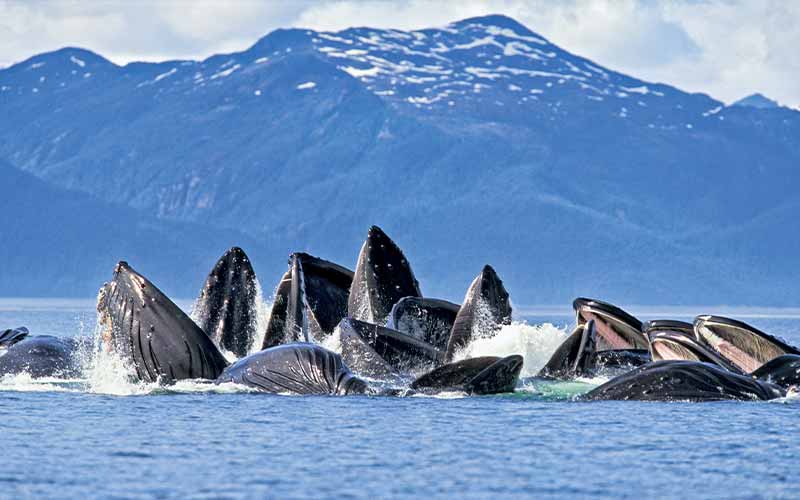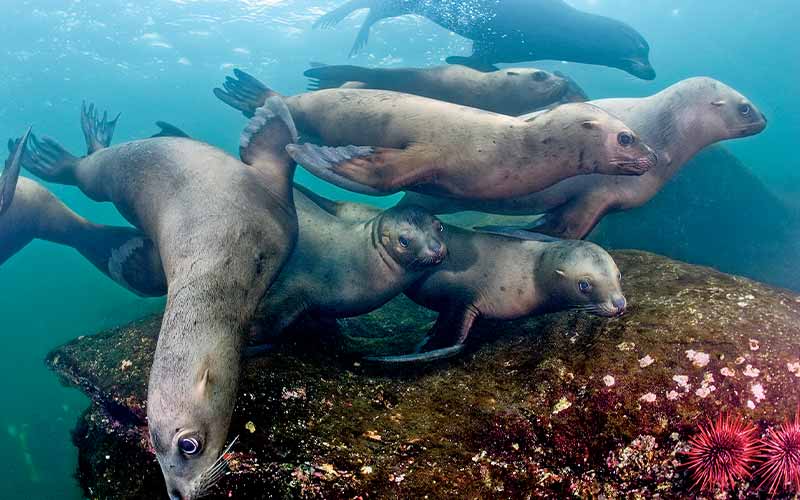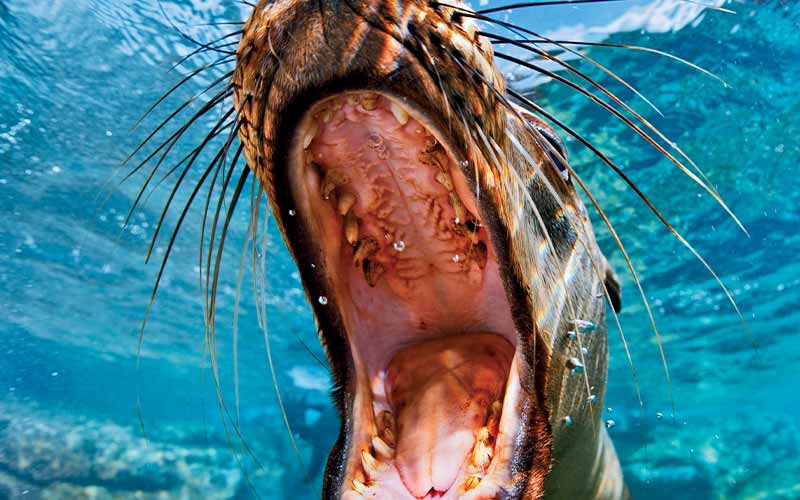It is always interesting to see the evolution of a passion — how geographic and inspirational hurdles are overcome and a career is achieved in spite of rather than because of. I had that thought as I listened to Brandon Cole, one of the world’s premier marine-wildlife photographers, describe his childhood, for there was very little in his early life to suggest the path he would embark upon.
As the son of an electrical engineer who worked assignments all over the world, Cole moved around nonstop through Europe and Asia during his childhood. Among all the changes, it was the ubiquitous access to the television adventures of Jacques Cousteau that kept him grounded, if dreams of the life aquatic can be considered a grounding force. He didn’t know how or when, but he knew his destiny was preordained: He would do something of significance in, on or related to the ocean.

When Cole finished high school, his family had moved to landlocked Spokane, Wash., and he was no closer to the sea — no nearer to his dream. But he was old enough to determine his own direction, and he chose a college near the ocean. As a student at the University of California, Santa Barbara, the smell of salt water and the sound of the surf revived his soul. Like so many who know they want to do something ocean-related but aren’t sure what, he majored in marine biology, and he even began working toward his doctorate. But he recognized a traditional career in science might tie him to a lab or an office, and he was more of an in-the-field kind of guy.
Photography was not even on his horizon until an assignment as an underwater researcher put him in contact with an established professional underwater photographer, Norbert Wu. Cole was a research diver on a vessel working in Southern California’s Channel Islands when Wu came aboard with an assignment to shoot mantis shrimp. Watching Wu work and listening to him talk about the business of underwater photography, Cole began to consider its potential. By the time he was in his junior year of college, photography became a plausible career for him. Yet being a practical person by nature, Cole did, in his words, “the smart, safe, expected thing: I secured a Ph.D. posting at Florida State University in Tallahassee.” Then almost immediately he asked for and received a research assignment in Australia.

Headed to the southern hemisphere with the opportunity to dive exotic waters, he realized he needed a proper underwater-camera system. Wu was selling one of his old ones, a Canon F-1 single-lens reflex camera in an Oceanic Hydro 35 housing. It was “battle-tested, used and abused,” Cole said, but it was commensurately cheap and had a proven record of bringing home images. Those first rolls of film weren’t all that great (the camera didn’t magically imbue him with the skill of its previous owner), so he learned the hard way, teaching himself through “trial and lots of error.”
He was on track for his grand plan, but life has a way of not going as predicted. Cole was in Australia for only a month when family tragedy struck. His father was killed, and Cole had to return home. His dad had owned a furniture store in Spokane Valley, and his mom asked if Cole wanted to take over the family business. But it was hardly a career path he could reconcile with his passion, so he declined, and his mom closed the store. A philosophical fork in the road appeared for Cole. Would he head back to Australia to continue working toward his doctorate, or would he try a career in underwater photography? Like so many who are just getting started, he had little to lose by giving photography a try, and by February 1993 he officially launched his career with a self-funded trip to Hawaii and the self-imposed task of making some photographs he could sell to a dive magazine.

Stephen Frink// That was a fairly bold direction, particularly back in the early 1990s. What made you think selling photos to dive magazines would work out for you?
Brandon Cole// I’d been following what you, Marty Snyderman, Rick Frehsee and Wu had been doing, so that was my guide for what to shoot and where to sell the pictures. I’d always been capable in the water, with a sound biological understanding of marine life and a good rapport with critters, but truthfully I was more of a math-and-science guy than a creative artist. Still, I persevered and had some very fortunate encounters. My first really productive photo session was with an aggressive oceanic whitetip shark. He tried to bite me, but while fending him off with my camera I made a dramatic image of a creature few had captured on film before.
That helped me get noticed — at first by magazines wanting freebies, of course, but opportunities to do business with those who paid came soon after. I knew from the very beginning that if I was to be respected as a working professional I should be compensated. So I ignored those who tried to sell me on the “glory of being a published photographer” and concentrated on those who realized I needed to eat, pay my rent, invest in new camera gear and fund dive travel to create new images. I can’t say it was a business plan yet, but it was a direction.
Fortunately I had emerged from school debt-free, and I sold everything to support my photography, including my motorcycle and car. That funded my early travel up and down the West Coast, from Baja to Alaska. It was my ramen-noodles era, just me and my camera for the most part. I occasionally partnered with other photographers to share expenses though. Stuart Westmorland and I worked together in the San Juan Islands looking for orcas, for example, and we dived extensively in the current-swept passes off Vancouver Island. The West Coast was close, relatively inexpensive and familiar, so that’s where I concentrated first.

SF// When I think of your photography I think of impressive photos of big, iconic animals like whales and sharks. I realize you are skilled at shooting dive models and reef scenics as well, but the big critters seem to have defined your career. How did that come about?
BC// My home waters were very fertile for big animals. I was covering subjects and habitats that were not already documented in great detail. At that time magazines like Skin Diver were investing a lot of assignment coverage in the Caribbean and Bahamas, but I felt if I stayed true to my roots and concentrated on things like humpbacks and killer whales and giant octopuses in temperate waters I could carve out a niche. Being based in Washington state meant considerable costs to mount Caribbean expeditions, so I didn’t. It was a combination of personal preference and practicality that kept me working close to home off the West Coast, but it was a function of the wealth of the marine life there that big animals became part of my repertoire.
I was good at sitting in a little boat for weeks on end waiting for things to happen. Determination and patience were my greatest attributes. One can learn the technical aspects of photography, but without patience and the willingness to invest considerable time with no guaranteed rewards I could not have capitalized on the photo opportunities I’ve had in my career. The early shoots were six weeks of self-funded rigor, and for years my life was all about finding enough money to buy a bag of rice and gas for my boat. I was driven, for sure, but not by fame. I wanted to create a way of life, to be successful enough so I could go where I wished and shoot what I wanted.

SF// How did you decide where you wanted to shoot? You were funding your own travel, so you had to feel confident you could make a return on those photos.
BC// I have always tried to select my subjects carefully. I would analyze the market to see if there were too many photos of a specific animal out there already. I had a sense that there were lots of photographers taking pictures of the same subjects in the same destinations and selling them to the same clients. I didn’t want that to be me, so my travel was usually for subjects that were difficult and remote, and that gets expensive. I could spend $2,000 to go on a liveaboard where accessibility is easy, I could do five dives per day on a Caribbean reef, or I could try my own thing: Spend a lot more money and be by myself with breaching whales. The latter plan, though risky, resonated with me more solidly.
In the end, the animals are what truly motivate me. The driving force over 20 years of photography is to be in or on the water with marine life. If I could, I’d leave the hassles of the camera behind and just interact with the creatures of the sea. I had this conversation with David Doubilet once. He was telling me all about the history and science of photography and the pioneer days of underwater image-making, and I told him I’m happy just to be in the water and pointing the camera in the right direction. We laughed and agreed to disagree about our approaches to photography.

SF// Your early monk-like discipline might be harder for you to sustain these days. You’re married, and while I know Melissa often travels with you, it still must be hard to spend the time on the road like you did when you started out.
BC// I’ve given my everything to this career, and while it may not be sustainable for another 20 or 30 years, particularly with current market dynamics, just being out in the wild still provides me with the energy and drive to carry on. Melissa and I have just celebrated our 16th anniversary. I take pictures, and she is an accomplished and successful marine-life artist. We don’t have kids, and she is very understanding and supportive of a career that keeps me on the road 150 days per year.
My work is primarily editorial in nature. I don’t teach or lead tours or even shoot much advertising photography. I’ve spent a lot of effort and money to build a strong big-animal collection, and I think this is important work. Many of the reefs and habitats I’ve photographed are in decline, but I don’t want my archive to only be about what we’ve lost, about “what it looked like before Armageddon.” All of us need to be ultra concerned with the sea in the coming 20 years; the near future will be pivotal. We’re killing sharks beyond the point they can recover, and the food chain is quickly losing balance. Pollution, habitat destruction, ocean acidification, human apathy, greed and misunderstanding plague our oceans.
While I don’t yet have a deep photo archive of the ugly things that man does to the ocean like a conservation photographer such as Brian Skerry might have, I do have images that celebrate much of what is beautiful and majestic about the ocean. It has taken me 20 years to build this collection, and I hope with all my being that the next two decades of my life can be dedicated to further exploration and documentation of the marine world.

SF// You and I have had many conversations over the years about the technology of the tools we use to capture images and the business of underwater photography. Do you have any new epiphanies to share?
BC// I’m always pondering what my next great camera upgrade will be, but I’m not a slave to it. I shoot both Canon and Nikon, and if the technology is there I will certainly experiment. But in the past few years I’ve slowed a bit in the quest to test everything. I see less reason to focus on acquiring ever-larger file sizes when so much of our work is going online and into mobile apps. There are cameras out there that are 36-megapixel and higher, but I wonder if the lenses are up to the resolution task. I’m more interested in advances in autofocus technology, high-ISO performance and extended dynamic range. Those are the kinds of things that will help me push forward, capturing new and, I hope, better images.

Regarding the business, as affordable megapixel performance goes up and advanced technology becomes more accessible to all, the perceived value of our photographs has dropped. A flood of images has saturated the marketplace, seemingly without any real sense of consequence or thought of ensuring a sustainable future for this profession. Stock-photo agencies are trying to make sales at any cost, which is a big reason we are managing most of my stock photography ourselves, and it is 100 percent rights-managed, not royalty-free or microstock. I know what went into making these images — the cost in time, travel and camera gear — and I know what clients were willing to pay just a few years ago. I’m not giving away my work for free or nearly free, and those with respect for themselves and their work shouldn’t either. I believe engaging, creative photography can still have real value, and I’m willing to stand up for it.
People tell me I am living the dream. And I am; part of it, anyway. Being my own boss means no one pays for my health insurance, and I don’t have a company-funded 401K. I love making the pictures, but that’s the easy part. I’ve consciously built a diverse portfolio, and I plan my assignments strategically. I do extensive research, consult local experts and quite often revisit destinations hoping to do something different than I or anyone else has done before.

SF// Is there a single image that defines your style and philosophy of photography?
BC// That’s a tough one with so many thousands of images, each with a story behind its capture. But my underwater orca is a good example of making luck happen.
I had tried shooting orcas underwater in almost every way imaginable: with polecams, on scuba, using a snorkel — everything. For this particular shot I’d been out for 14 days straight, spending 15 hours a day in my boat. I won’t say I was getting skunked, because I had seen whales. But I certainly wasn’t having any success making underwater images. The picture I so desperately wanted, and so clearly saw in my mind’s eye, remained out of reach. Finally, I needed a break from the frustration and decided to do a pleasure dive on the reef to look for wolf eels or photograph the kelp. I was in my drysuit, hanging alongside the boat and preparing to descend when I heard the familiar sound of a whale exhaling and saw the distinctive high dorsal fins of orcas. They were close and heading toward me. It wasn’t outrageous that they were approaching — I’ve known them to be curious about boats — but for once I was in the water, in the right place at the right time with my camera in hand.

They came by for one close pass, and I nailed a few shots. I was prepared, but I was also incredibly lucky. I may never replicate that shot; it is highly unlikely all the necessary factors will come together like that again. As I see it, the moral to that story is to treat every dive, every expedition, as if it is your last one, and make every moment of light count. If I ever give up on a shoot it will be back in my office, after the fact, not while I’m still in the field. To me, persistence and dedication are as important as memory cards and fresh batteries. Perhaps most important of all is the willingness to truly immerse oneself in the wild.
© Alert Diver — Q3 Summer 2012